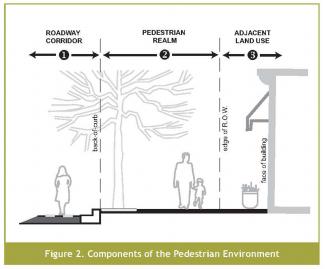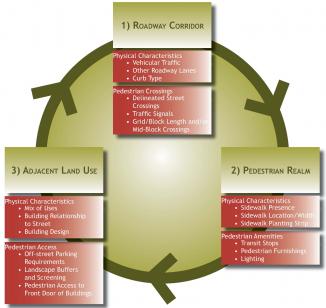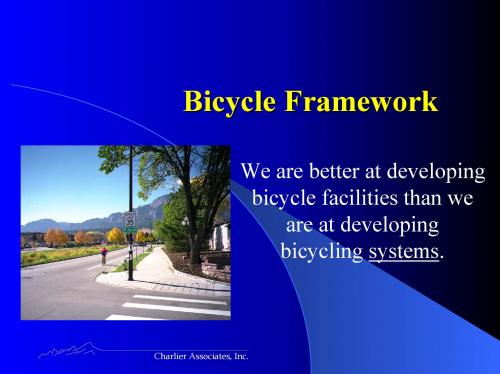Active Living By Design
June 14, 2005
†
†
†
†
†
Charlier Associates, Inc.ís core expertise is planning multimodal environments.† Over the past decade CAI has worked with several communities to expand transportation systems that support active living.† Recently, CAI has been participating in local and national discussions on the topic.† CAI has been sharing techniques for building high quality non-motorized environments.††††
†
†
†

The Building Livable Communities in Colorado Conference was organized by the Livable Communities Support Center and held in Golden, Colorado.† Terri Musser and Jim Charlier presented techniques for planning bicycle and pedestrian networks.† After the presentation Terri and Jim conducted a walking tour of downtown Golden to apply the techniques discussed in the presentation.† The presentation and other relevant materials are included below.
Workshop Presentation

Recommended: Right-click file to save file to your computer; or, click on link to open in a new browser window.


Pedestrian Science
CAIís work with communities across the country has led to the development of the pedestrian science.† This science is a simple yet effective way to characterize pedestrian environments.† The following information was presented at the conference and tested in the afternoon walking tour.


Pedestrian Places
These are districts of limited extent, with mixed-use land development, moderate to high densities, good transit service, great streets, and extensive pedestrian accommodation in the form of sidewalks, crosswalks, and other facilities. Here people will stroll and linger past store fronts and urban landscape features, walking for both utilitarian and recreational purposes.††
The acid test for qualifying a place as a pedestrian destination is the actual ongoing presence of significant numbers of people.† Pedestrian Places have people moving about between multiple activities -- typically at least three highly identifiable areas such as outdoor seating, a water feature, and pedestrian-oriented shopping.
††
 |
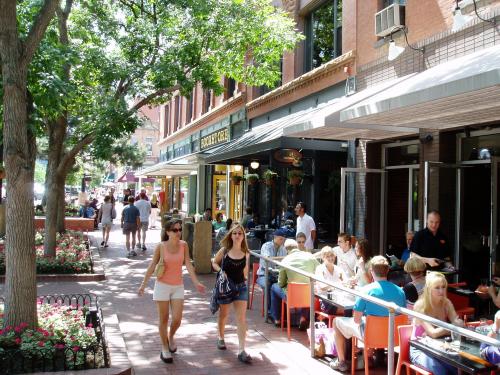 |

Pedestrian Supportive Environments
These include well-designed residential and commercial neighborhoods, employment centers, parks and recreational areas. These are safe environments for walking, where sidewalks are continuous and buffered from streets, wide enough for passing and walking side by side, and where good street crossings have been provided. Land uses are either dense enough to both generate and attract utilitarian walking trips of reasonably short lengths (half mile or less), or are of the sort that will attract recreational walkers and joggers. Buildings, not parking lots, face streets.
A good test to know if an environment is Pedestrian Supportive is whether or not a parent would feel comfortable letting a child walk ahead of them with minimal supervision.
†
 |
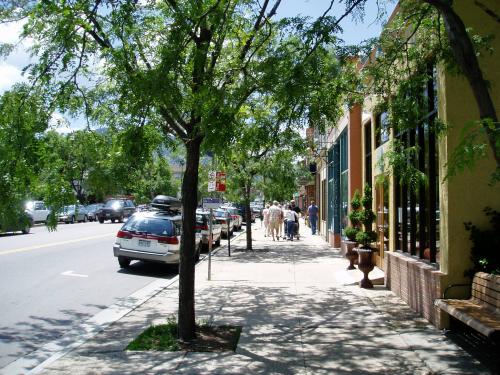 |

Pedestrian Tolerant Environments
These are areas and corridors where walking is technically safe (there are continuous sidewalks and some kind of reasonably safe street crossings), but the land use patterns are such that little walking activity is likely to be generated. These include arterial street corridors, remote or rural streets and certain light industrial or warehousing areas.
Such places will only attract limited amounts of utilitarian walking, and will not appeal to recreational walkers or strollers. Tolerant environments provide pedestrian facilities, but include a very minimal level of accommodation.
 |
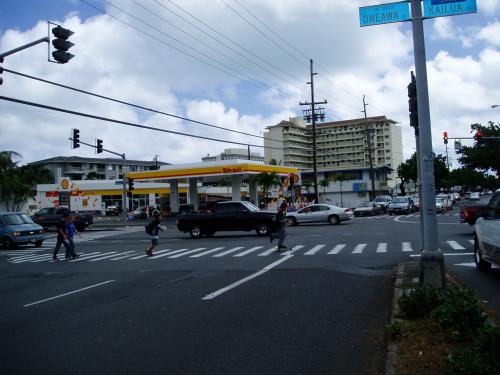 |

Pedestrian Intolerant Environments
This is a polite term for pedestrian hostile areas where walking is unsafe and unattractive. Examples include freeway corridors, certain industrial or extraction land uses, landfills, and major streets and roadways lacking continuous sidewalks. A major characteristic of Intolerant environments is that they lack pedestrians, either due to a lack of pedestrian accommodations and/or dominance by automobile traffic and auto-oriented land uses.†


The Denver Local Area Leadership Workshop is comprised of elected officials and municipal staff that are concerned with planning issues in the Denver region.† Members gather to share ideas for the region and build partnerships.† Jim Charlier presented an overview of the active living by design movement and strategies for building multimodal transportation systems in their communities.† The examples below highlight the importance of building pedestrian and bicycle facilities.††


Pedestrian environments are often thought of just a sidewalks and crosswalks.† To help develop walkable communities CAI has been developing a pedestrian planning science.† The science highlights the importance of traffic, land use, and infrastructure integration when planning for pedestrians.

Bicycle networks are a major part of active living communities.†† Most communities have bicycle facilitates, but very few have a network that provides cross-town travel.† CAI offers some case studies from communities who have taken on the challenge of building bicycle networks.
†

The concluding thoughts to the Active Leadership Workshop imparted Jim Charlier 30 years of transportation planning expertise.††
†

Link to Active Living Network's Website


 http://www.activeliving.org/
http://www.activeliving.org/

« Previous Page | Print Page 

